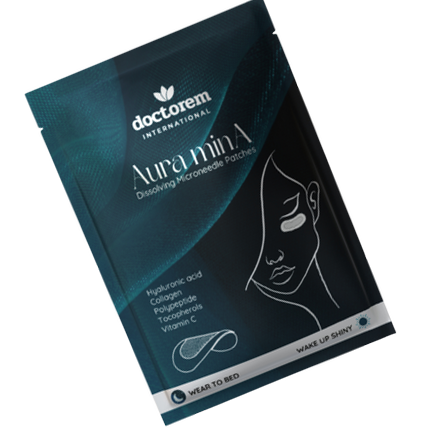Doctorem Aura Mina Under Eye Mask: Revolution in Under Eye Care with Micro Needle Technology
The area around the eyes is one of the areas where the skin is most sensitive and thin. Signs of stress, fatigue and aging quickly manifest themselves in this area. Doctorem Aura Mina offers an innovative solution using micro-needle technology, specially developed for under-eye care. In this article, we will examine in detail what Aura Mina is, its unique features, benefits and how to use it.
What is Doctorem Aura Mina Eye Mask?
Doctorem Aura Mina is a high-tech care patch specially designed for the under-eye area. Each patch contains 2000 collagen-loaded microneedles. These micro needles have been specially developed to meet the needs of the sensitive skin around the eyes and ensure deep penetration of active ingredients into the skin.
What is Doctorem Aura Mina Used for?
Aura Mina's microneedle technology aims to improve the health and appearance of the under-eye area. Thanks to this innovative system:
- Collagen and other active ingredients penetrate deeper into the skin
- Helps effectively reduce under-eye puffiness
- Visibly reduces the appearance of fine lines and wrinkles
- Intensively moisturizes and nourishes the eye area
- Helps reduce the appearance of dark circles
- Significantly increases the elasticity of the skin around the eyes
- Stimulates the skin's own collagen production
- In general, it makes the eye area look more vibrant, fuller and more vigorous
How to Use Aura Mina?
- Clean and dry your eye area carefully
- Remove the under-eye patch from its packaging
- Apply the tape carefully to the under eye area
- Ensure the microneedles penetrate the skin by pressing lightly
- Keep the tape in place for 2-4 hours
- Remove the tape and gently rub the remaining serum into your skin
It is recommended to use 1-2 times a week. Due to microneedles, overuse should be avoided.
Ingredients, Benefits and Scientific Foundations
Doctorem Aura Mina contains many ingredients that are beneficial for the skin health around the eyes. Here are the main ingredients, their potential benefits and the scientific research that supports them:
- Micro Needle Collagen
- Benefit: Penetrates deep into the skin, increases skin elasticity, reduces wrinkles.
- Scientific Basis: It has been shown in clinical studies that microneedle technology increases the penetration of collagen and other active ingredients into the skin and promotes skin regeneration [1].
- Hyaluronic Acid
- Benefit: Deeply moisturizes the skin, reduces the appearance of fine lines.
- Scientific Basis: It has been shown in clinical studies that hyaluronic acid increases skin moisture and reduces wrinkles [2].
- Peptides
- Benefit: Supports skin regeneration, reduces the appearance of wrinkles.
- Scientific Basis: Various studies have proven that peptides accelerate skin regeneration and reduce wrinkles [3].
- Tocopherols (Vitamin E)
- Benefit: It is a powerful antioxidant, prevents skin damage.
- Scientific Basis: Vitamin E has been shown to slow skin aging and protect against UV damage [4].
- Vitamin C
- Benefit: Supports collagen production, equalizes skin tone.
- Scientific Basis: It has been proven by clinical studies that vitamin C increases collagen synthesis and reduces skin pigmentation [5].
These scientific findings support the potential benefits of the ingredients contained in Aura Mina. Micro-needle technology increases the effects of these active ingredients by allowing them to penetrate deeper into the skin.
Sources:
- Singh A, Yadav S. (2016). Microneedling: Advances and widening horizons. Indian Dermatology Online Journal, 7(4), 244-254.
- Pavicic T, et al. (2011). Efficacy of cream-based novel formulations of hyaluronic acid of different molecular weights in anti-wrinkle treatment. Journal of Drugs in Dermatology, 10(9), 990-1000.
- Lintner K, et al. (2000). The effect of a synthetic ceramide-2 on transepidermal water loss after stripping or sodium lauryl sulfate treatment: an in vivo study. International Journal of Cosmetic Science, 22(2), 85-95.
- Thiele JJ, Ekanayake-Mudiyanselage S. (2007). Vitamin E in human skin: organ-specific physiology and considerations for its use in dermatology. Molecular Aspects of Medicine, 28(5-6), 646-667.
- Stamps JM, et al. (2017). The Roles of Vitamin C in Skin Health. Nutrients, 9(8), 866.
